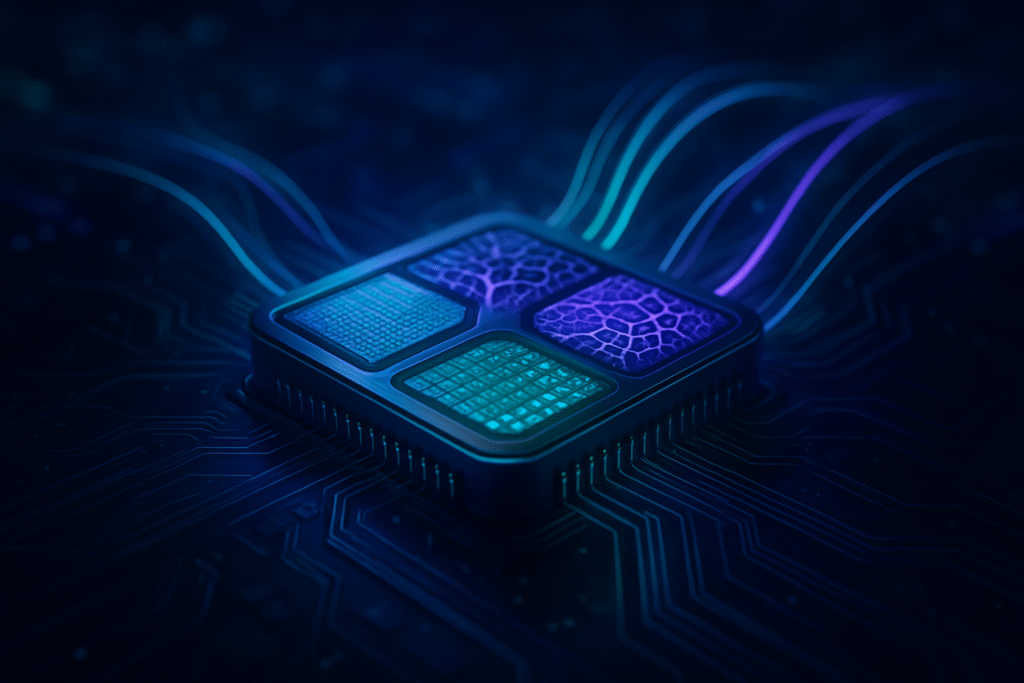
The artificial intelligence landscape is currently experiencing a profound transformation, moving beyond the ubiquitous general-purpose GPUs and into a new frontier of highly specialized semiconductor chips. This strategic pivot, gaining significant momentum in late 2024 and projected to accelerate through 2025, is driven by the escalating computational demands of advanced AI models, particularly large language models (LLMs) and generative AI. These purpose-built processors promise unprecedented levels of efficiency, speed, and energy savings, marking a crucial evolution in AI hardware infrastructure.
This shift signifies a critical response to the limitations of existing hardware, which, despite their power, are increasingly encountering bottlenecks in scalability and energy consumption as AI models grow exponentially in size and complexity. The emergence of Application-Specific Integrated Circuits (ASICs), neuromorphic chips, in-memory computing (IMC), and photonic processors is not merely an incremental upgrade but a fundamental re-architecture, tailored to unlock the next generation of AI capabilities.
The Architectural Revolution: Diving Deep into Specialized Silicon
The technical advancements in specialized AI chips represent a diverse and innovative approach to AI computation, fundamentally differing from the parallel processing paradigms of general-purpose GPUs.
Application-Specific Integrated Circuits (ASICs): These custom-designed chips are purpose-built for highly specific AI tasks, excelling in either accelerating model training or optimizing real-time inference. Unlike the versatile but less optimized nature of GPUs, ASICs are meticulously engineered for particular algorithms and data types, leading to significantly higher throughput, lower latency, and dramatically improved power efficiency for their intended function. Companies like OpenAI (in collaboration with Broadcom [NASDAQ: AVGO]), hyperscale cloud providers such as Amazon (NASDAQ: AMZN) with its Trainium and Inferentia chips, Google (NASDAQ: GOOGL) with its evolving TPUs and upcoming Trillium, and Microsoft (NASDAQ: MSFT) with Maia 100, are heavily investing in custom silicon. This specialization directly addresses the "memory wall" bottleneck that can limit the cost-effectiveness of GPUs in inference scenarios. The AI ASIC chip market, estimated at $15 billion in 2025, is projected for substantial growth.
Neuromorphic Computing: This cutting-edge field focuses on designing chips that mimic the structure and function of the human brain's neural networks, employing "spiking neural networks" (SNNs). Key players include IBM (NYSE: IBM) with its TrueNorth, Intel (NASDAQ: INTC) with Loihi 2 (upgraded in 2024), and Brainchip Holdings Ltd. (ASX: BRN) with Akida. Neuromorphic chips operate in a massively parallel, event-driven manner, fundamentally different from traditional sequential processing. This enables ultra-low power consumption (up to 80% less energy) and real-time, adaptive learning capabilities directly on the chip, making them highly efficient for certain cognitive tasks and edge AI.
In-Memory Computing (IMC): IMC chips integrate processing capabilities directly within the memory units, fundamentally addressing the "von Neumann bottleneck" where data transfer between separate processing and memory units consumes significant time and energy. By eliminating the need for constant data shuttling, IMC chips offer substantial improvements in speed, energy efficiency, and overall performance, especially for data-intensive AI workloads. Companies like Samsung (KRX: 005930) and SK Hynix (KRX: 000660) are demonstrating "processing-in-memory" (PIM) architectures within DRAMs, which can double the performance of traditional computing. The market for in-memory computing chips for AI is projected to reach $129.3 million by 2033, expanding at a CAGR of 47.2% from 2025.
Photonic AI Chips: Leveraging light for computation and data transfer, photonic chips offer the potential for extremely high bandwidth and low power consumption, generating virtually no heat. They can encode information in wavelength, amplitude, and phase simultaneously, potentially making current GPUs obsolete. Startups like Lightmatter and Celestial AI are innovating in this space. Researchers from Tsinghua University in Beijing showcased a new photonic neural network chip named Taichi in April 2024, claiming it's 1,000 times more energy-efficient than NVIDIA's (NASDAQ: NVDA) H100.
Initial reactions from the AI research community and industry experts are overwhelmingly positive, with significant investments and strategic shifts indicating a strong belief in the transformative potential of these specialized architectures. The drive for customization is seen as a necessary step to overcome the inherent limitations of general-purpose hardware for increasingly complex and diverse AI tasks.
Reshaping the AI Industry: Corporate Battles and Strategic Plays
The advent of specialized AI chips is creating profound competitive implications, reshaping the strategies of tech giants, AI labs, and nimble startups alike.
Beneficiaries and Market Leaders: Hyperscale cloud providers like Google, Microsoft, and Amazon are among the biggest beneficiaries, using their custom ASICs (TPUs, Maia 100, Trainium/Inferentia) to optimize their cloud AI workloads, reduce operational costs, and offer differentiated AI services. Meta Platforms (NASDAQ: META) is also developing its custom Meta Training and Inference Accelerator (MTIA) processors for internal AI workloads. While NVIDIA (NASDAQ: NVDA) continues to dominate the GPU market, its new Blackwell platform is designed to maintain its lead in generative AI, but it faces intensified competition. AMD (NASDAQ: AMD) is aggressively pursuing market share with its Instinct MI series, notably the MI450, through strategic partnerships with companies like Oracle (NYSE: ORCL) and OpenAI. Startups like Groq (with LPUs optimized for inference), Tenstorrent, SambaNova Systems, and Hailo are also making significant strides, offering innovative solutions across various specialized niches.
Competitive Implications: Major AI labs like OpenAI, Google DeepMind, and Anthropic are actively seeking to diversify their hardware supply chains and reduce reliance on single-source suppliers like NVIDIA. OpenAI's partnership with Broadcom for custom accelerator chips and deployment of AMD's MI450 chips with Oracle exemplify this strategy, aiming for greater efficiency and scalability. This competition is expected to drive down costs and foster accelerated innovation. For tech giants, developing custom silicon provides strategic independence, allowing them to tailor performance and cost for their unique, massive-scale AI workloads, thereby disrupting the traditional cloud AI services market.
Disruption and Strategic Advantages: The shift towards specialized chips is disrupting existing products and services by enabling more efficient and powerful AI. Edge AI devices, from autonomous vehicles and industrial robotics to smart cameras and AI-enabled PCs (projected to make up 43% of all shipments by the end of 2025), are being transformed by low-power, high-efficiency NPUs. This enables real-time decision-making, enhanced privacy, and reduced reliance on cloud resources. The strategic advantages are clear: superior performance and speed, dramatic energy efficiency, improved cost-effectiveness at scale, and the unlocking of new capabilities for real-time applications. Hardware has re-emerged as a strategic differentiator, with companies leveraging specialized chips best positioned to lead in their respective markets.
The Broader Canvas: AI's Future Forged in Silicon
The emergence of specialized AI chips is not an isolated event but a critical component of a broader "AI supercycle" that is fundamentally reshaping the semiconductor industry and the entire technological landscape.
Fitting into the AI Landscape: The overarching trend is a diversification and customization of AI chips, driven by the imperative for enhanced performance, greater energy efficiency, and the widespread enablement of edge computing. The global AI chip market, valued at $44.9 billion in 2024, is projected to reach $460.9 billion by 2034, growing at a CAGR of 27.6% from 2025 to 2034. ASICs are becoming crucial for inference AI chips, a market expected to grow exponentially. Neuromorphic chips, with their brain-inspired architecture, offer significant energy efficiency (up to 80% less energy) for edge AI, robotics, and IoT. In-memory computing addresses the "memory bottleneck," while photonic chips promise a paradigm shift with extremely high bandwidth and low power consumption.
Wider Impacts: This specialization is driving industrial transformation across autonomous vehicles, natural language processing, healthcare, robotics, and scientific research. It is also fueling an intense AI chip arms race, creating a foundational economic shift and increasing competition among established players and custom silicon developers. By making AI computing more efficient and less energy-intensive, technologies like photonics could democratize access to advanced AI capabilities, allowing smaller businesses to leverage sophisticated models without massive infrastructure costs.
Potential Concerns: Despite the immense potential, challenges persist. Cost remains a significant hurdle, with high upfront development costs for ASICs and neuromorphic chips (over $100 million for some designs). The complexity of designing and integrating these advanced chips, especially at smaller process nodes like 2nm, is escalating. Specialization lock-in is another concern; while efficient for specific tasks, a highly specialized chip may be inefficient or unsuitable for evolving AI models, potentially requiring costly redesigns. Furthermore, talent shortages in specialized fields like neuromorphic computing and the need for a robust software ecosystem for new architectures are critical challenges.
Comparison to Previous Milestones: This trend represents an evolution from previous AI hardware milestones. The late 2000s saw the shift from CPUs to GPUs, which, with their parallel processing capabilities and platforms like NVIDIA's CUDA, offered dramatic speedups for AI. The current movement signifies a further refinement: moving beyond general-purpose GPUs to even more tailored solutions for optimal performance and efficiency, especially as generative AI pushes the limits of even advanced GPUs. This is analogous to how AI's specialized demands moved beyond general-purpose CPUs, now it's moving beyond general-purpose GPUs to even more granular, application-specific solutions.
The Horizon: Charting Future AI Hardware Developments
The trajectory of specialized AI chips points towards an exciting and rapidly evolving future, characterized by hybrid architectures, novel materials, and a relentless pursuit of efficiency.
Near-Term Developments (Late 2024 and 2025): The market for AI ASICs is experiencing explosive growth, projected to reach $15 billion in 2025. Hyperscalers will continue to roll out custom silicon, and advancements in manufacturing processes like TSMC's (NYSE: TSM) 2nm process (expected in 2025) and Intel's 18A process node (late 2024/early 2025) will deliver significant power reductions. Neuromorphic computing will proliferate in edge AI and IoT devices, with chips like Intel's Loihi already being used in automotive applications. In-memory computing will see its first commercial deployments in data centers, driven by the demand for faster, more energy-efficient AI. Photonic AI chips will continue to demonstrate breakthroughs in energy efficiency and speed, with researchers showcasing chips 1,000 times more energy-efficient than NVIDIA's H100.
Long-Term Developments (Beyond 2025): Experts predict the emergence of increasingly hybrid architectures, combining conventional CPU/GPU cores with specialized processors like neuromorphic chips. The industry will push beyond current technological boundaries, exploring novel materials, 3D architectures, and advanced packaging techniques like 3D stacking and chiplets. Photonic-electronic integration and the convergence of neuromorphic and photonic computing could lead to extremely energy-efficient AI. We may also see reconfigurable hardware or "software-defined silicon" that can adapt to diverse and rapidly evolving AI workloads.
Potential Applications and Use Cases: Specialized AI chips are poised to revolutionize data centers (powering generative AI, LLMs, HPC), edge AI (smartphones, autonomous vehicles, robotics, smart cities), healthcare (diagnostics, drug discovery), finance, scientific research, and industrial automation. AI-enabled PCs are expected to make up 43% of all shipments by the end of 2025, and over 400 million GenAI smartphones are expected in 2025.
Challenges and Expert Predictions: Manufacturing costs and complexity, power consumption and heat dissipation, the persistent "memory wall," and the need for robust software ecosystems remain significant challenges. Experts predict the global AI chip market could surpass $150 billion in 2025 and potentially reach $1.3 trillion by 2030. There will be a growing focus on optimizing for AI inference, intensified competition (with custom silicon challenging NVIDIA's dominance), and AI becoming the "backbone of innovation" within the semiconductor industry itself. The demand for High Bandwidth Memory (HBM) is so high that some manufacturers have nearly sold out their HBM capacity for 2025 and much of 2026, leading to "extreme shortages." Leading figures like OpenAI's Sam Altman and Google's Sundar Pichai warn that current hardware is a significant bottleneck for achieving Artificial General Intelligence (AGI), underscoring the need for radical innovation.
The AI Hardware Renaissance: A Concluding Assessment
The ongoing innovations in specialized semiconductor chips represent a pivotal moment in AI history, marking a decisive move towards hardware tailored precisely for the nuanced and demanding requirements of modern artificial intelligence. The key takeaway is clear: the era of "one size fits all" AI hardware is rapidly giving way to a diverse ecosystem of purpose-built processors.
This development's significance cannot be overstated. By addressing the limitations of general-purpose hardware in terms of efficiency, speed, and power consumption, these specialized chips are not just enabling incremental improvements but are fundamental to unlocking the next generation of AI capabilities. They are making advanced AI more accessible, sustainable, and powerful, driving innovation across every sector. The long-term impact will be a world where AI is seamlessly integrated into nearly every device and system, operating with unprecedented efficiency and intelligence.
In the coming weeks and months (late 2024 and 2025), watch for continued exponential market growth and intensified investment in specialized AI hardware. Keep an eye on startup innovation, particularly in analog, photonic, and memory-centric approaches, which will continue to challenge established players. Major tech companies will unveil and deploy new generations of their custom silicon, further solidifying the trend towards hybrid computing and the proliferation of Neural Processing Units (NPUs) in edge devices. Energy efficiency will remain a paramount design imperative, driving advancements in memory and interconnect architectures. Finally, breakthroughs in photonic chip maturation and broader adoption of neuromorphic computing at the edge will be critical indicators of the unfolding AI hardware renaissance.
This content is intended for informational purposes only and represents analysis of current AI developments.
TokenRing AI delivers enterprise-grade solutions for multi-agent AI workflow orchestration, AI-powered development tools, and seamless remote collaboration platforms.
For more information, visit https://www.tokenring.ai/.





